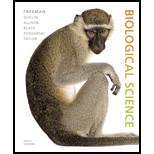
Concept explainers
What is chromatin?
a. the histone-containing protein core of the nucleosome
b. the 30-nm fiber
c. the complex of DNA and proteins found in the nucleus
d. the histone and non-histone proteins in eukaryotic nuclei
Introduction:
Chromatin is mostly found in the cells, comprising of the DNA (deoxyribonucleic acid), RNA (ribonucleic acid), and protein. There are three levels of chromatin organization, namely, euchromatin, heterochromatin, and high-level DNA packaging of the fiber into the metaphase chromosome.
Answer to Problem 1TYK
Correct answer:
The DNA and histone together form chromatin. The packaging of the double helical structure of DNA is done by the histones.
Explanation of Solution
Explanation/Justification for the correct answer:
Option (c) is given as the assemblage of proteins and DNA in the nucleus is called chromatin. A gene expresses itself in a number of stages in a cell. These stages are transcription and translation. Prior to transcription, the DNA remains bound with proteins in the nucleus and is called as chromatin. Hence, Option (c) is correct.
Explanation for incorrect answers:
Option (a) is given as the histone that contains the protein core of the nucleosome. The nucleosome is a part of DNA with its proteins, which consists of a small segment of DNA held together by histone proteins. This is a part of chromatin and its repeated units give rise to complete chromatin. So, it is an incorrect option.
Option (b) is given as the 30-nm fiber. The H1 histones interact with one another and with the histone proteins in the adjacent nucleosome providing them a regular position. This structure is called as 30-nm (nanometer) fiber. So, it is an incorrect option.
Option (d) is given as the histone and non-histone proteins present in the nuclei of the eukaryotic cells. The proteins that bind DNA in the nucleus in eukaryotic cells are called histones. They are a part of chromatin. The proteins other than the histone proteins in the chromatin like DNA polymerase, scaffold proteins, polycomb proteins, and heterochromatin protein 1 are called as non-histone proteins. So, it is an incorrect option.
Hence, options (a), (b), and (d) are incorrect.
The main function of the chromatin is to effectively package the DNA into a small area in order to fit the DNA into the nucleus of the cell. It also protects the structure and sequence of the DNA.
Want to see more full solutions like this?
Chapter 19 Solutions
Biological Science (6th Edition)
- Which region of DNA is the site of spindle fiber attachment during mitosis and meiosis? A. the telomere B. the operator C. the terminator D. the promoter E. the centromerearrow_forwardContrast euchromatin and heterochromatin. Then explain how DNA can transition from one to the other. Use the terms histone, nucleosome, and acetylation.arrow_forwardDescribe the appearance and composition of chromatin and the structure of nucleosomes. Comment on the significance of histone proteins.arrow_forward
- The form of DNA that contains genes that are actively beingtranscribed is calleda. histones.b. telomeres.c. heterochromatin.d. euchromatin.arrow_forwardIn a nucleosome, what is the DNA wrapped around? A. mRNA B. Nucleolus protein. C. Ribosomes. D. Polymerase molecules. E. Histonesarrow_forwardA nucleosome consists of (a) DNA and scaffolding proteins (b) scaffolding proteins and histones (c) DNA and histones (d) DNA, histones, and scaffolding proteins (e) histones onlyarrow_forward
- Biologists have long been interested in the effects of radiation on cells. In one experiment, researchers examined the effect of radium on mitosis of chick embryo cells growing in culture. A population of experimental cells was examined under the microscope for the number of cells in telophase (as a measure of mitosis occurring) before, during, and after exposure to radium. The results are shown in the Figure. What is the effect of radium exposure on mitosis? Source: R. G. Canti and M. Donaldson. 1926. The effect of radium on mitosis in vitro. Proceedings of the Royal Society of London, Series B, Containing Papers of a Biological Character 100:413419.arrow_forwardHeterochromatin consists of a) region of euchromatin devoid of histones. b) an AT-rich region occurs every 200 base pairs. c) decondensed, transcriptionally active chromatin. d) highly condensed, transcriptionally inactive chromatinarrow_forwardWhat happens to microtubules in the presence of very high levels of GTP? A. They will undergo treadmilling B. They will grow rapidly C. They become unstable and may undergo catastrophy D. They will shrinkarrow_forward
- 1. What does heterochromatin mean? a. The genes are expressed and it is involved with gene activation. b. The genes are expressed and it is involved with gene silencing. c. The genes are not expressed and it is involved with gene silencing. d. The genes are not expressed and it is involved with gene activationarrow_forwardOther than obvious changes in protein-encoding Neanderthal genes, changes in what type of non-coding DNA sequences would affect cell function? A) Alu family of repeated sequences B) Short tandem repeats (STRs) C) Protein factors that regulate gene expression D) Short interspersed nuclear elements (SINEs)arrow_forwardCompare and contrast the structure of DNA and RNA. During Prophase of Mitosis, chromosomes begin to condense and are fully condensed by the time the cell is in Metaphase of Mitosis. Explain how the chromatin organizes itself from the beginning of prophase to metaphase of mitosis.arrow_forward
 Biology (MindTap Course List)BiologyISBN:9781337392938Author:Eldra Solomon, Charles Martin, Diana W. Martin, Linda R. BergPublisher:Cengage Learning
Biology (MindTap Course List)BiologyISBN:9781337392938Author:Eldra Solomon, Charles Martin, Diana W. Martin, Linda R. BergPublisher:Cengage Learning
 Biology: The Dynamic Science (MindTap Course List)BiologyISBN:9781305389892Author:Peter J. Russell, Paul E. Hertz, Beverly McMillanPublisher:Cengage Learning
Biology: The Dynamic Science (MindTap Course List)BiologyISBN:9781305389892Author:Peter J. Russell, Paul E. Hertz, Beverly McMillanPublisher:Cengage Learning


